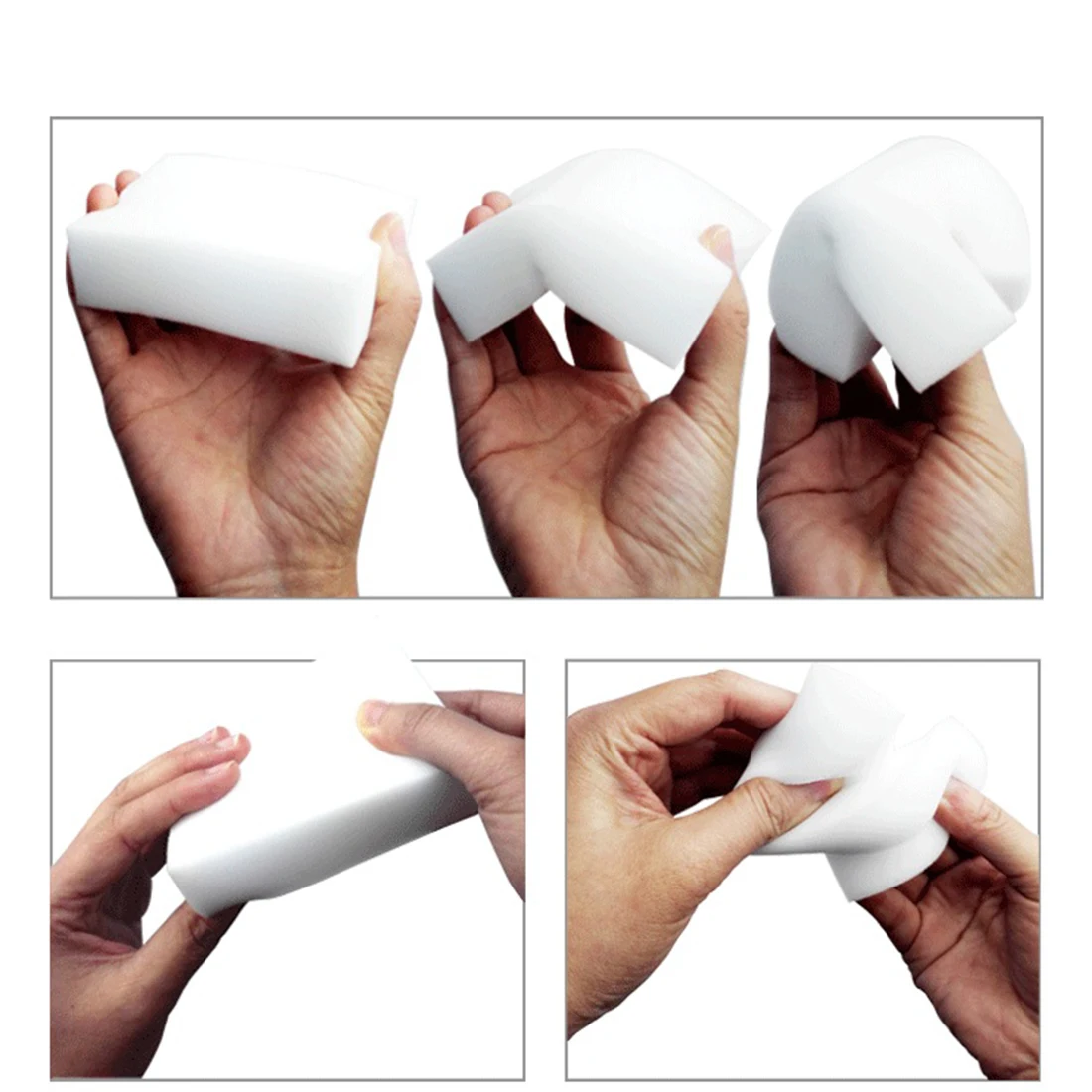
Remove wine or juice stains from Formica counters. Make bathroom faucets and handles sparkle like new. Wipe away stuck-on splatters inside your microwave. Remove rust rings in your tub or bathroom sink. Eliminate years of build-up from curling irons and flat irons. Remove burnt-on grime from glass baking dishes. Scrubs off sticky label residue from wine bottles and glass jars. Remove layers of soap scum from shower doors. Whiten greying grout and bring back your tile’s shine. 
Eliminate baked-on grease and food splatters from oven doors.Remove scuff marks, crayon, pen, and marker stains from walls and baseboards.Our dirty dozen list of ordinary cleaning chores Magic Eraser will ace: And never use a Magic Eraser without doing a spot test first. The surface of the Magic Eraser is abrasive and potentially harmful on skin. Be sure, though, whenever you use a Magic Eraser, to put gloves on. For tougher stains, a bit of extra elbow grease should do the trick. With a simple wipe across the surface, most stains are history.

Ordinary dirt, grime, and sticky messes are no match for Magic Eraser. Jenn Huls/Shutterstock What are Magic Erasers safe to use on?
Screens. The Magic Eraser would quickly scratch and ruin the screen. One-of-a-kind collectibles. If you have something that holds sentimental value, don’t test out Magic Eraser on it. Stainless steel. Like natural stone, Magic Eraser can make stainless steel look dull. Magic Eraser can scratch the surface, and then that coating can get in your food. Natural stone surfaces, including granite and marble. You can damage the sealant and make your countertop appear lifeless and dull. Your car. You can damage the paint job. Wood. Magic Erasers can scratch and strip the finish. Shiny painted, enameled, sealed, or varnished surfaces. Magic Erasers don’t magically erase everything - here’s where not to use them: While there are plenty of Magic Eraser uses, there are also times you should find another cleaning method. Try not to use it on high-gloss surfaces, as the abrasiveness could permanently dull the luster of the finish. Overall, it’s fabulous at cleaning so many different types of messes around your home, especially in your kitchen and bathroom. If you’re at all unsure if you should use Magic Eraser on a specific surface, do a quick ‘patch’ test before committing to the cleaning project. There are some surfaces that this cleaning product is too abrasive for. Balsaz Justin/Shutterstock When not to use Magic EraserĬan you use Magic Eraser on any surface? Definitely not. It’s like a hand-sanding machine with a built-in vacuum function. The resin is the scraper, the air bubbles are the absorber, and if anything survives that powerful one/two punch, a bit more pressure will break the melamine down into even more tiny abrasive particles. When you rub Magic Eraser across a surface, the blend of melamine resin and those microscopic air bubbles work together to clean, unlike any other product. Those hardened melamine resin threads are sharp when broken - similar to shards of glass. Now that we know a Magic Eraser is not a sponge, what is it? It’s actually blocks of melamine foam, comprised of microscopic air bubbles encased by threads of hardened melamine resin - and it’s every bit as tough as it sounds. SHARKY PHOTOGRAPHY/Shutterstock How does Magic Eraser work? To ensure you don’t end up a victim of Magic Eraser regret, you need to know when you can - and can’t - use Magic Eraser for cleaning. They are a deceptively abrasive and effective cleanser. I take a little, tiny piece of it and wet it, don’t touch your gums… I’ve been doing it for, like, two years.”ĭunn’s video is now accompanied by a TikTok warning that states: “The action in this video could result in serious injury.Even though Magic Erasers look a bit like ordinary sponges, they are most definitely not a sponge. “Number three, and here is where we all gasp. When the dentist says, ‘use your fluoride, don’t rinse,’ umm… no, I don’t do that… Number two, I do something called oil pulling,’ I look it up on YouTube and I use coconut oil… “Step number one, I don’t use any fluoride at all. 
I go to the dentist, and I don’t tell them what I do, but they’re like, ‘you have the healthiest, strongest, cleanest teeth,’ and I’m like, ‘why, thank you.’ “Yes, I am prepared for all the dentists that are going to come on here and be like, ‘don’t do it, she’s crazy!’ I don’t care. According to WFTV, the trend started in June when TikToker Heather Dunn shared her controversial teeth-whitening routine in a video she posted where she said:







 0 kommentar(er)
0 kommentar(er)
